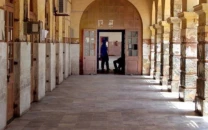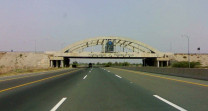Politics in Gilgit-Baltistan

Politics in Gilgit-Baltistan
This disillusionment has emerged in the aftermath of an ongoing natural disaster, which started when a massive landslide on the Hunza river in early January caused the formation of an artificial lake. Over the last four months, the overflowing lake has destroyed hundreds of acres of agricultural, residential, and commercial land in the upper Hunza area of Gojal, while also blocking the Karakoram Highway and submerging two bridges. The only road link between Pakistan and China is now disrupted. Over 20,000 people have already had to move to IDP camps, and 50,000 more could also be affected as the lake continues to swell.
Many in Gilgit-Baltistan argue that the damage could have been reduced if the government had taken the disaster seriously much earlier, and released water from the lake. People have strong grievances against the National Disaster Management Authority, the Frontier Works Organization, and the Gilgit-Baltistan government for their lack of political will, technical incompetence, and overall posture of normalcy throughout the past four months. The situation in Gilgit-Baltistan also raises larger questions about the politics of disaster relief in Pakistan. When the 2005 earthquake hit Azad Kashmir, there was an overwhelming public response accompanied by sustained relief efforts. Part of the reason for this response was the sheer magnitude of the tragedy, but part of it was also because Kashmir has been constructed as the bedrock of nationalist ideology in Pakistan, and hence, intimately appeals to our national sentiment. When a devastating cyclone hit Balochistan in June 2007, the relief efforts by the Pakistani government were dismal and the humanitarian Pakistani spirit was also conspicuously missing. As the situation in Gilgit-Baltistan becomes worse, it remains to be seen whether the region will also meet the fate of Balochistan in terms of political negligence.
It is also important to note that in the case of the 2007 cyclone and flash floods in Balochistan, a key factor that aggravated the damage was the ill-planned Mirani dam. In the ongoing Gilgit-Baltistan disaster, a warning issued by the flood forecasting division has similarly pointed out that the massive landslide can potentially be traced to an earthquake that resulted from blasting done by KKH constructors. This needs serious attention, as development visions in Gilgit-Baltistan have increasingly promoted the widening of the KKH as well as the creation of dams without a thorough assessment of the social and ecological impact of such mega-projects. In the wake of the Hunza disaster, the very need of these mega-projects needs to debated and reconsidered, particularly given the fragile terrain of the region. As a nation that is increasingly affected by natural disasters, we also need to re-evaluate our political and economic priorities. We need to ask why our civilian authorities remain so woefully under-equipped to deal with disasters, and why an already over-stretched military is the key decision-making and implementing authority in the context of a disaster. Most importantly, we need to ask why our resources are overwhelmingly spent on developing missiles, instead of facilitating disaster preparedness and humanitarian relief.
The immediate need, of course, is to provide care and compensation to those who have been affected by the tremendous loss of homes and livelihoods. People are extremely angry about the political disregard that has caused the loss of their land, which is the source of their history, identity, and life. These grievances add to an already existing sense of alienation that stems from the denial of constitutionally guaranteed fundamental rights to the region, under the garb of the Kashmir issue.
In the short-term, the least we can do is to whole-heartedly support local relief efforts. Among other sources, donations can be made to the Gojal Emergency Relief Fund, Account Number 851405, The First Micro Finance Bank, Sost Gojal, Branch Code 0208.
Published in the Express Tribune, May 25th, 2010.



















COMMENTS
Comments are moderated and generally will be posted if they are on-topic and not abusive.
For more information, please see our Comments FAQ